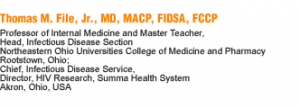Smarter Therapy: Guidelines for Optimal Management of Neutropenic Cancer Patients (Interview with Professor Thomas M. File, Jr.)
![]()


The Infectious Diseases Society of America (IDSA) has recently updated the clinical practice guidelines for the use of antimicrobial agents in neutropenic patients. Expanding on earlier guidelines, the latest publication provides a clear protocol for physicians treating cancer patients who develop fever and neutropenia. The need for rapid empiric antibiotic therapy in these patients is highlighted, as is the importance of stratifying patients into high or low risk based on specific features. An overview of the updated guidelines is given here by Professor Thomas File, Jr. He also outlines the importance of these international guidelines for Asian physicians and provides a comprehensive summary on the role of individual antimicrobials.
Questions
| Introduction |
| Q01 | What are the most important factors relating to antibiotic management of febrile neutropenia? |
| Criteria for the selection of antibiotics |
| Vital points of the 2010 updated Infectious Diseases Society of America (IDSA) guidelines |
| Recommendations to Asian physicians who treat neutropenic patients |










